The Lost Canyon of Ica | Everything about this Hidden Wonder in Peru
Hidden among golden dunes and mysterious rock formations, the Lost Canyon of Ica is a unique geological wonder in the heart of the Ica Desert. Stretching over 5 kilometers, this impressive labyrinth of clay walls sculpted by time is one of Peru’s most fascinating and least-explored attractions.
It is a place where small turquoise lagoons contrast with the rock formations and remnants of a distant past. If you’re looking for an off-the-beaten-path destination near Lima, the capital of Peru, the Lost Canyon of Ica is an unforgettable experience. Thanks to Kantu Peru Tours, we will explore its history, geological origins, characteristics, location, how to get there, travel tips, and everything that makes this place a hidden gem in the Ica Desert.
What is the Lost Canyon of Ica?
The Lost Canyon of Ica is an impressive geological formation located in the Ocucaje Desert, just a few hours from the city of Ica. It is characterized by its majestic eroded walls in ochre and reddish tones, which contrast with small turquoise lagoons, creating a landscape that seems straight out of another planet.
Unlike more famous canyons, such as the Colca Canyon, the Lost Canyon of Ica stands out for its isolation and enigmatic aura, making it the perfect destination for travelers seeking authentic adventure.
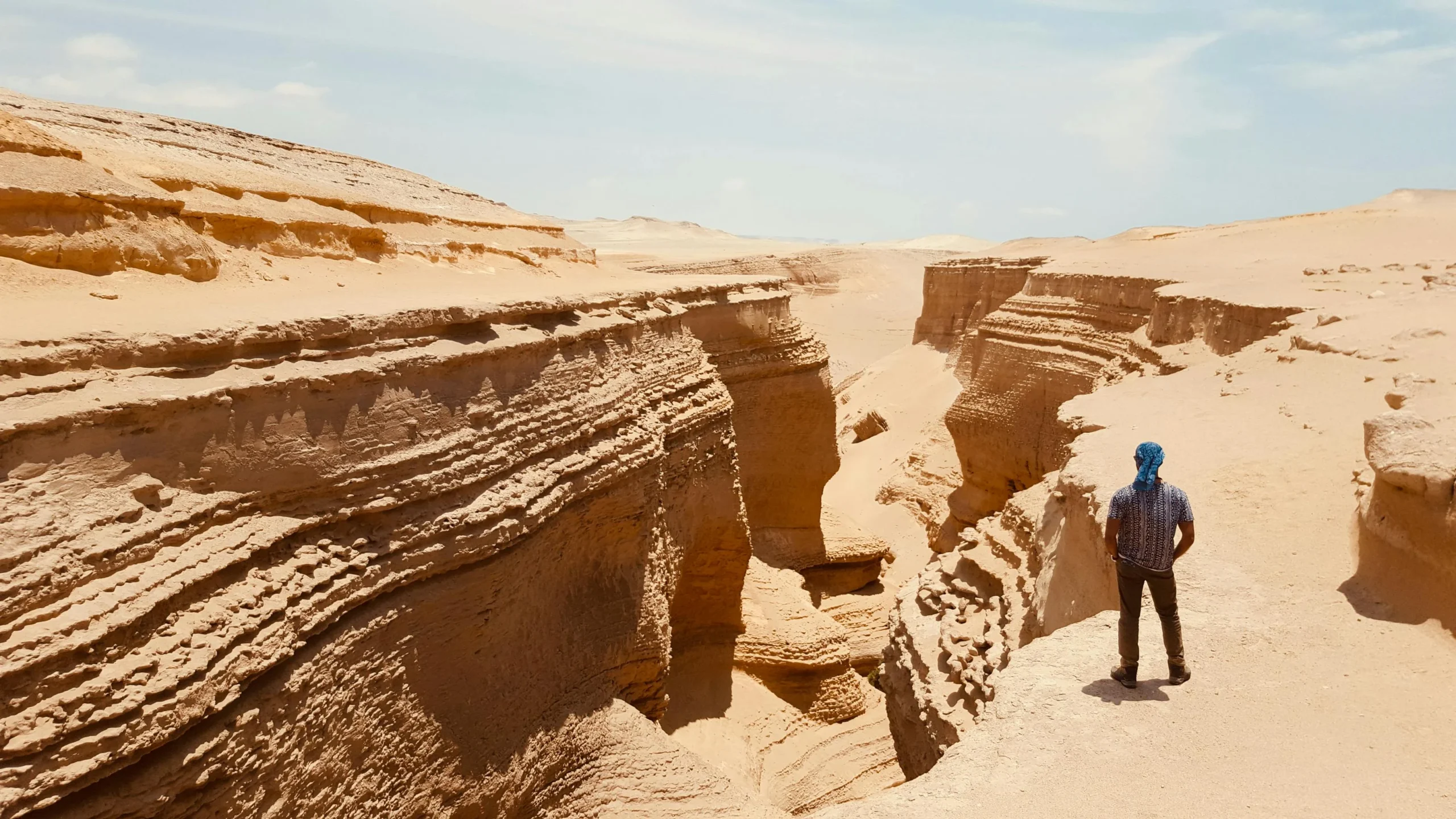
A tourist in the Lost Canyon of Ica
History of the Lost Canyon of Ica
The Lost Canyon of Ica owes its name to an interesting anecdote, in July 2011, a group of explorers from the Association for Tourism and Cultural Promotion of Ocucaje (APTYCO) ventured into the desert in search of this place but took the wrong route and never reached it.
It was journalist Maycol Herrera Bendezú, a correspondent for the Correo newspaper in Ica, who finally discovered it and named it the “Lost Canyon of Ica” in honor of that failed expedition.
The Vultures: Guardians of the Canyon
One of the most fascinating details of the Lost Canyon of Ica is the presence of vultures soaring over the area as guardians. Their majestic flight adds a mystical touch to the landscape.
Considered true masters of survival, these vultures have become a natural symbol of this impressive destination, guiding visitors to water sources and offering a unique spectacle of connection with nature.

Gallinazo el ave protectora del Cañon de los Perdidos
How Was the Lost Canyon of Ica Formed?
Millions of years ago, the Lost Canyon of Ica was not a desert but part of the Pacific Ocean. According to studies, it was formed over the course of the now-disappeared Río Seco de Ica, and its current structure is the result of millennia of erosion by water and wind.
Paleontological studies reveal that the rocks of the Lost Canyon of Ica are between 20 and 30 million years old, and fossils of whales, sharks, marine shells, and even prehistoric penguins have been found—clear evidence that this area was once a rich marine ecosystem.
Why visit the Lost Canyon of Ica?
→ Unique Landscapes: A paradise for photography, with stunning rock formations and crystal-clear lagoons.
→ Pure Adventure: Perfect for trekking and exploration, far from mass tourism.
→ Living History: A journey into the past through fossils and geological structures.
→ Connection with Nature: A peaceful oasis in the Ica Desert.
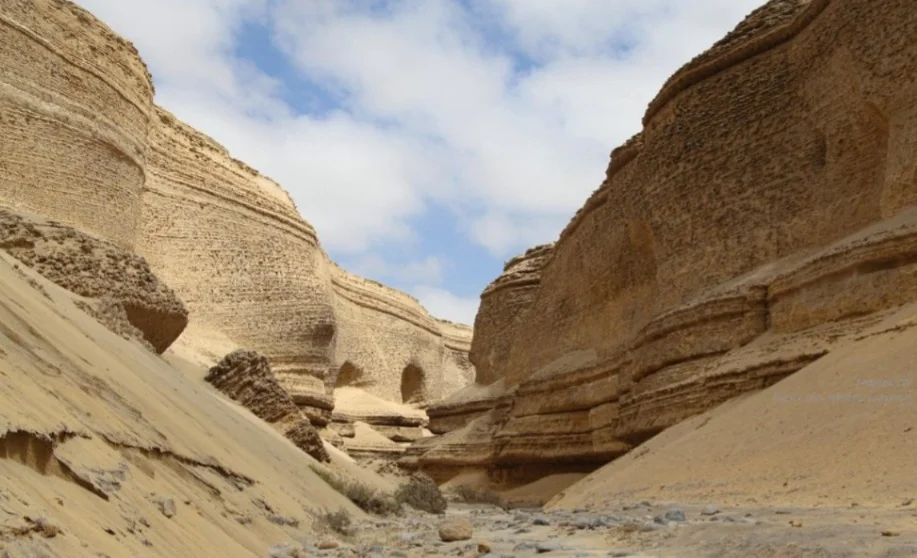
Cañón de los Perdidos Ica un Fotografía general
Where is the Lost Canyon of Ica Located?
This breathtaking natural wonder is situated in the Ica Region, between the districts of Santiago and Ocucaje, specifically in the Montegrande area, the canyon is part of a vast geological formation that reveals millions of years of natural history, where sedimentary layers and marine fossils tell the prehistoric story of this region.

Mapa para llegar al Cañón de los Perdidos desde Ica
How to Get to the Lost Canyon of Ica?
The canyon is 69 km southeast of the city of Ica, about 2.5 hours by car, due to its remote location in the desert, it is highly recommended to hire a specialized tour operator to ensure a safe and enriching visit. A professional guide will take you along the correct routes and provide insights into the whale, shark, and other prehistoric animal fossils found in the area.
Option 1: Independent Travel
If you decide to go on your own, take the Panamericana Sur Highway (Km 339) and turn onto the dirt road leading to Caserío de Callango, near the old Río Seco riverbed. The drive (preferably in a 4×4 vehicle) takes about 2 hours, followed by a 30-minute walk to the canyon. Although the path is marked by the Municipality of Santiago, it is advisable to bring a GPS or a local guide to avoid getting lost. Upon arrival, you’ll be greeted by vultures, the canyon’s natural guardians.

Paradero de Souveniers en Ica
Option 2: Organized Tour
The safest and most recommended way to visit is by joining a guided tour with authorized travel agencies such as Kantu Peru Tours, which offers a fully organized trip, including pickup from Ica (hotels or bus terminals) and a stop in Ocucaje, an area famous for its marine fossils.
From the canyon’s viewpoint, you can admire its 150-meter-deep and 1.5-kilometer-long crevice. The tour also includes hikes to the inner lagoons, passing through saltpeter deposits and fossil sites. To top it all off, the experience ends with a tasting of artisanal pisco and wine at a local winery before returning.

Fotografía de los paseos en bote a la laguna Huacachina Ica Peru en la Zona Hotelera
What to See in the Lost Canyon of Ica?
The Viewpoint: A Panoramic View of the Canyon
Between the first and second levels of the canyon lies The Viewpoint, a strategic spot offering a spectacular view of this impressive gorge. From here, you can observe sedimentary layers that reveal millions of years of geological history, as well as the curious rock formations sculpted by wind and erosion. It’s the perfect place for panoramic photography and to fully grasp the magnitude of this natural wonder.
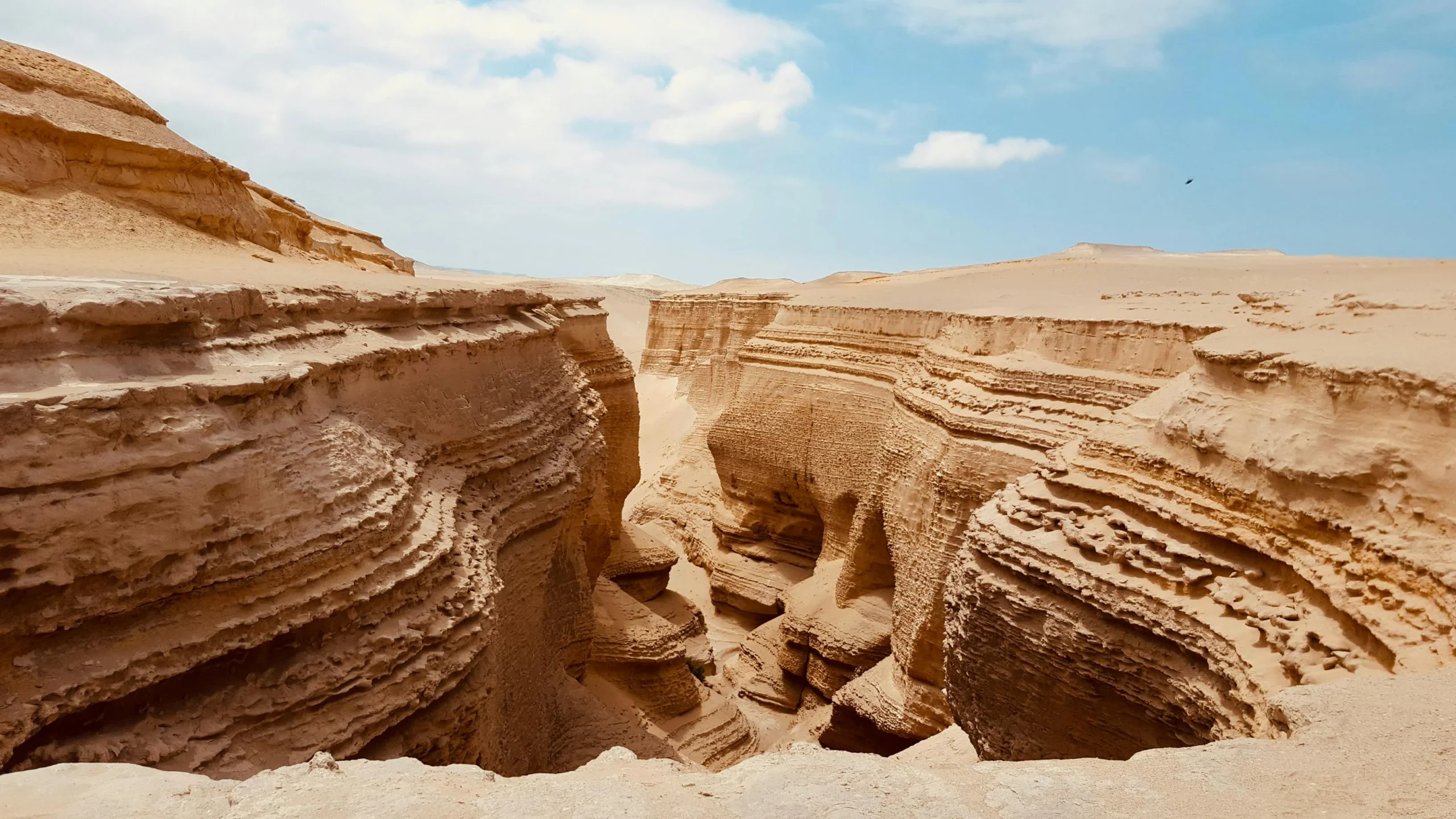
A Photo from the Viewpoint in the Lost Canyon of Ica
The Puma’s Face and Fish Eye
On the second level of the canyon, you’ll find two of its most iconic formations, the Puma’s Face is an impressive rock formation that, when viewed from the right angle, clearly resembles the profile of a feline, as if nature itself had sculpted it with artistic precision. Just below, you’ll find The Fish Eye, a small pool of crystal-clear water fed by underground filtrations, creating a refreshing contrast against the arid desert landscape.
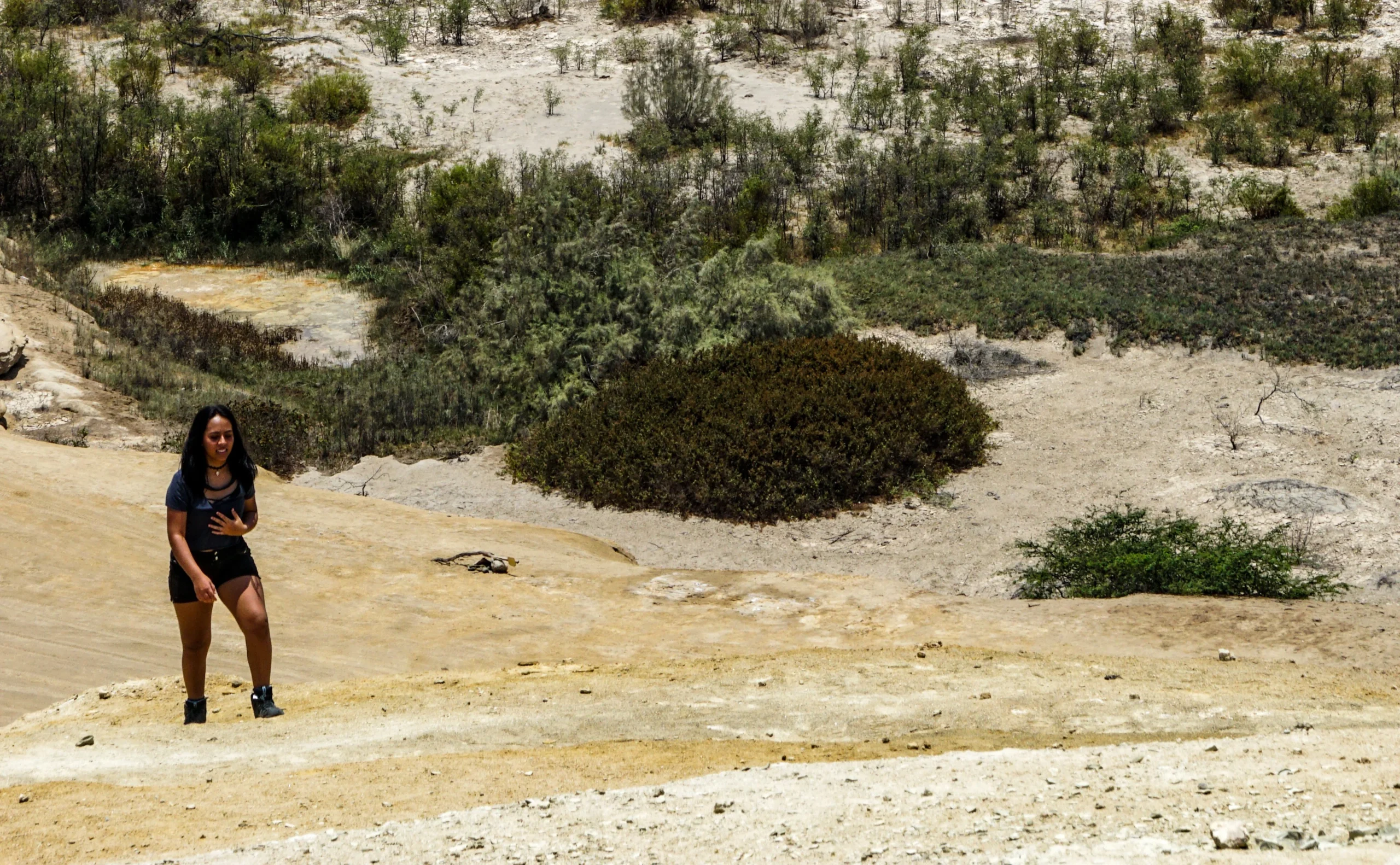
Una Turista en el Cañón de los perdidos Ica
The Mysterious Stone Plains
This unique area of the canyon is home to extraordinary rock formations that defy imagination—some resemble a toad, a dove, or even a giant tooth. Local legends suggest these formations might be the result of a meteorite impact that scattered the rocks in peculiar patterns. Meanwhile, geologists study them as fascinating examples of differential erosion.

The Stone Plains in the Lost Canyon of Ica
The Mouth of the Ica River
Where the canyon meets the Ica River, the landscape changes dramatically. Here, the presence of water allows for vegetation growth, attracting various migratory birds, especially herons, which find a vital refuge in the middle of the desert. This small oasis offers a striking contrast to the canyon’s dry walls and is an excellent spot for birdwatching and resting in the shade.
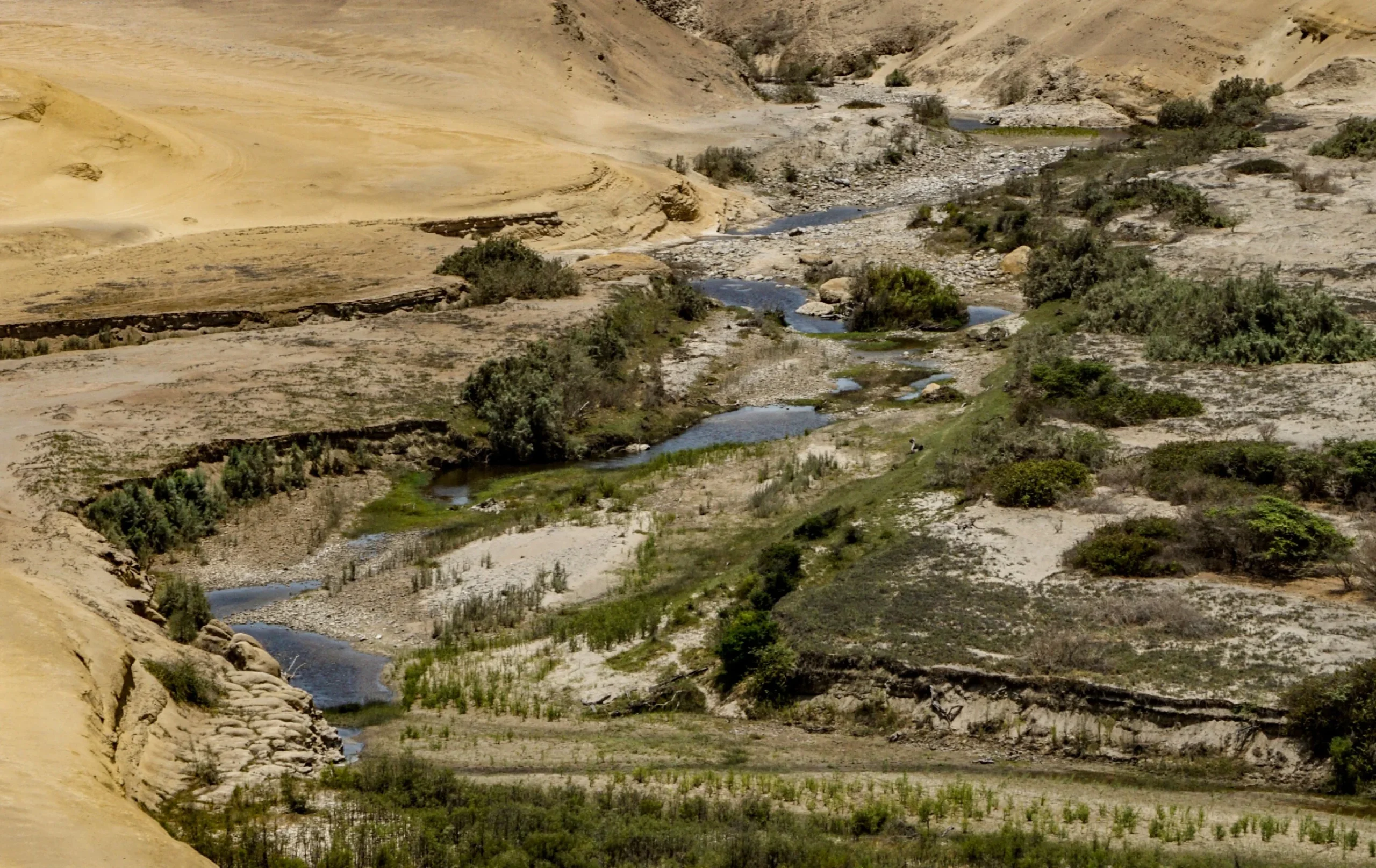
Rio en Ica – Desembocadura del Rio de la Huacachina
Plaza Caracol: A Unique Formation
Named by journalist Luis Miranda, Plaza Caracol owes its name to its spiral-like shape. This formation features a natural “semi-roof” that provides shade and protection, making it an ideal resting spot during your exploration. Its unique structure makes it one of the most photogenic locations in the canyon.
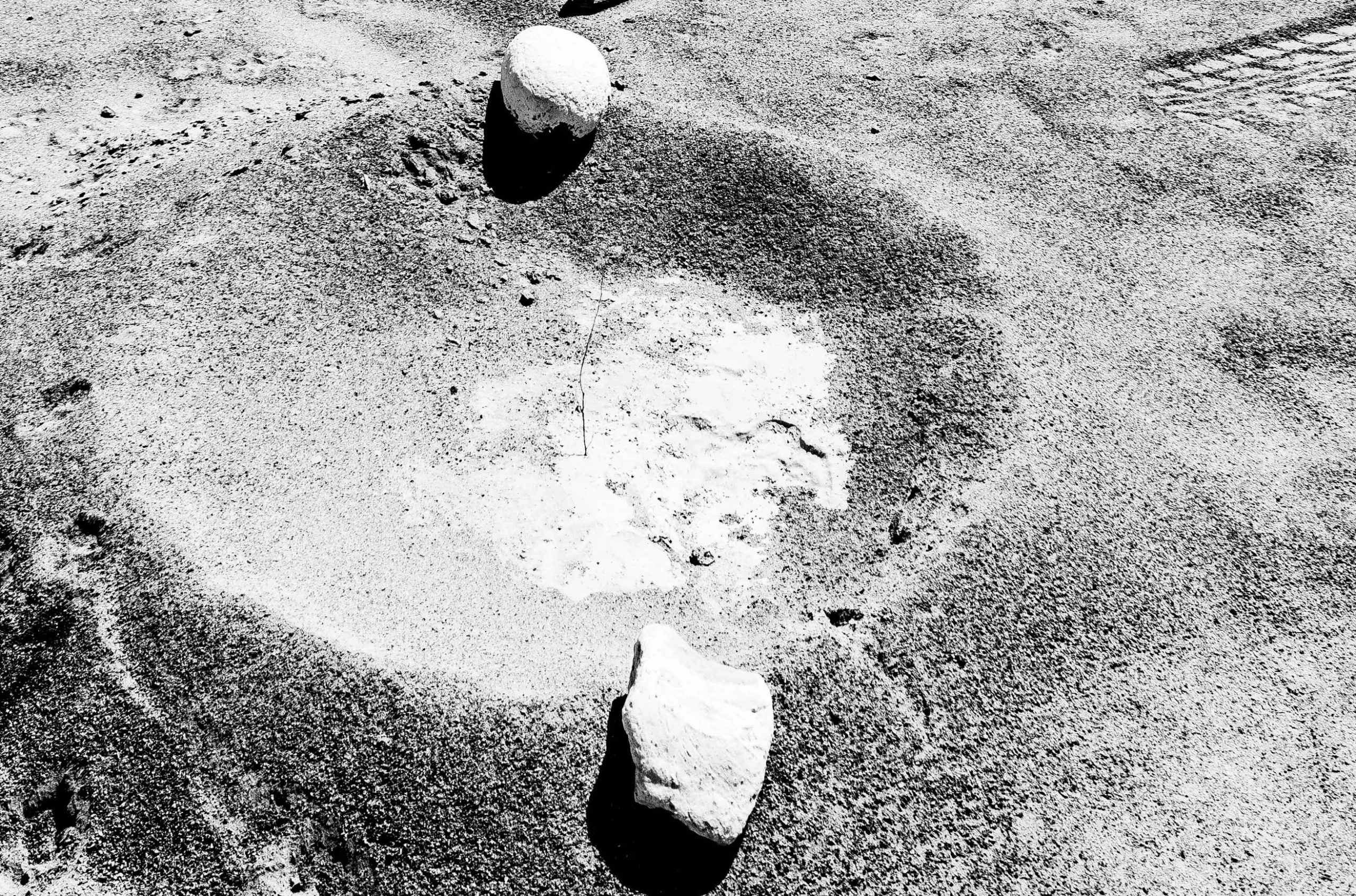
Imagenes del Cañon de los Perdidos
Discover More Wonders of Ica
Huacachina Lagoon: The Hidden Oasis Among Dunes
Just 5 km from the city of Ica, Huacachina Lagoon emerges like a mirage in the desert, this natural oasis, unique in South America, is surrounded by towering dunes that reach up to 100 meters in height and palm trees swaying in the breeze.
According to local legend, the lagoon was formed from the tears of a beautiful green-eyed princess who mourned the loss of her love. Today, this magical place is the perfect setting for thrilling buggy rides over the dunes and sandboarding sessions at sunset.

La Huachina en Ica Peru
The Pisco Route: The Heart of Peru’s Winemaking Tradition
Ica is the birthplace of Pisco, Peru’s beloved national spirit. Visiting its traditional wineries means diving into over 400 years of winemaking history. In these colonial haciendas, artisanal methods are still used to produce some of the best wines and piscos in the country.
During a winery tour, you’ll have the chance to grape stomp in ancient presses, learn about the fermentation process, and enjoy a free tasting of pure piscos, fruit-infused macerations, and creamy liqueurs.

Pisco Sour Peruano – Una bebida tradicional de Pisco Ica
Chincha: The Cradle of Afro-Peruvian Culture
About 50 km north of Ica, Chincha is a land of music, dance, and deep-rooted traditions. Here, you can visit family-run wineries like El Racimo de Uva, famous for producing cachina, a young and sweet wine typical of the region.
The experience is enriched with tastings of “mamajuana”, an aphrodisiac liquor made with local herbs, and delicious traditional sweets like tejas de manjar blanco. But Chincha is more than just wine—it’s the birthplace of festejo, a vibrant Afro-Peruvian music and dance genre. Here, you can experience live performances that will make you move to contagious rhythms.

Preparación de Vinos en Chincha Ica
Tips for Your Visit to the Ica Lost Canyon
✔️ Stay Hydrated & Use Sun Protection: The desert climate is extreme.
✔️ Wear Proper Footwear: Ideal for walking on sandy and rocky terrain.
✔️ Bring a Camera: You won’t want to miss these stunning landscapes.
✔️ Hire a Specialized Guide: To get the most out of the experience and learn about the geology and paleontology of the area.

Desierto de la Huacachina- Foto de Turistas Caminando
The Lost Canyon of Ica is a geological, paleontological, and photographic adventure, blending surreal landscapes with ancient history. Don’t forget to explore the other treasures of Ica to enjoy a complete experience!
If this guide has been useful and inspired you to visit the Lost Canyon, feel free to share it with more travelers. At Kantu Peru Tours, we are more than happy to assist you in planning your trip to Peru and help you have an unforgettable experience.
If you have any further questions, contact us, and we’ll be happy to provide all the information you need. Don’t forget to like and share this blog with other adventurers! 🌵📸









